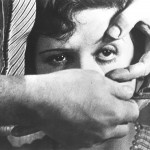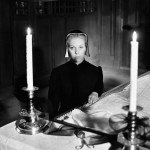I can’t seem to muster enough energy to even care about the Reagan mini-series hubbub; carving out a nuanced position is completely beyond me. For largely economic reasons, CBS seems to have caved to partisan political pressure, which is lame and disheartening but neither illegal nor censorship. It’s not even particularly surprising. Come to think of it, I might actually be more offended by the idea of there being a Reagan biopic starring James Brolin than by the fact that I won’t get to see it. I mean, who would want to?
I am intrigued, though, by the rising tide of commentary that links the mini-series with Angels in America. Frank Rich got the ball rolling with his piece in the Sunday Times. Then, yesterday, Andrew Sullivan posted a response at The New Republic. And now there’s word that Showtime will bump up its broadcast of the Reagan movie to November 30, exactly one week before HBO’s big premiere. In the Post article, Lisa de Moraes explains that Showtime President Robert Greenblatt “denied speculation that [his network] moved up the airdate to Nov. 30 because The Reagans, with all its juicy, audience-attracting controversy, was in grave danger of becoming roadkill when HBO debuted its adaptation of Tony Kushner’s Pulitzer Prize-winning play.” Greenblatt’s motivations are actually irrelevant to me; I’m more interested in the fact that the media has made that leap on its own, connecting the two films in a hotly politicized context.
All three links are worth a read — I’m especially excited by Rich’s claim that “Angels is the most powerful screen adaptation of a major American play since Elia Kazan’s Streetcar Named Desire more than a half-century ago” — but I’m going to limit my comments to Sullivan’s piece, and, more specifically, to one aspect of it: his strangely ambivalent dismissal of Kushner’s play as “good Stalinist agitprop.” (I’m tempted also to take on his equally bizarre claim that “networks aren’t supposed to be” biased, but I’ll leave that argument to others better equipped and motivated to do so.)
It is perhaps worth mentioning here at the start that Sullivan and Kushner have, as they say, “a history.” I haven’t followed it all too closely, but it’s been public at least since June ’94, when they appeared together, along with Donna Minkowitz and Bruce Bawer, on the Charlie Rose show to discuss the 25th anniversary of Stonewall. I haven’t seen the episode, but based on the transcript (available in Tony Kushner in Conversation) it appears that they spent a good portion of the evening throwing jabs at one another — Kushner accusing Sullivan of knocking down paper tigers, “one of them is the politics of the Left, as though there’s one politics of the Left”; Sullivan accusing Kushner of being “stuck in the McCarthy period….stuck in the late 1960s.” There was also Kushner’s commencement speech at Vassar, in which he took a none-too-subtle jab at “those newfangled neo-con gay people with their own website and no day job.” I don’t read Sullivan often enough to know if he responded in kind.
But back to the piece in The New Republic. Sullivan writes:
Exhibit A in the attempt to turn the human tragedy of AIDS into political agitprop was Tony Kushner’s Angels in America. As such, it appealed and still appeals to the hard left, which is partly why it won a Pulitzer and entirely why Frank Rich of The New York Times single-handedly championed it in the 1990s.
That Angels is a fiercely political play goes without saying. And, yes, I imagine that its particular politics would be more appealing to those of a leftist bent. But to reduce the play to agitprop — a rhetorical ploy of the laziest variety — demands a grossly simplistic reading of a work that delights in ambiguity. Later, Sullivan seems to acknowledge as much in a back-handed compliment, calling Kushner’s play “a magical realist fantasy — where dreams become enacted, angels appear, and all sorts of metaphors are turned into dramatic imagery.” Even Roy Cohn, who Sullivan (accurately) describes as “an emblem of all the hard left despises,” is treated by Kushner with tremendous grace. Sure, the character Louis describes Cohn as “the pollstar of human evil,” but anyone who has seen or read the play with at least a modicum of maturity and human understanding will surely remember Roy’s death scene — a moment of suffering and humor and mourning and, perhaps most surprising of all, forgiveness. (I can’t wait to see Pacino and Streep together.)
To be fair, Sullivan’s biggest beef here seems to be with Rich, who I would agree makes some questionable argumentative leaps. But Sullivan makes too many of his own. The historical record, he writes, “is complicated, hemmed in by political and scientific realities that neither Kushner nor Rich want to explore. Why? Because such nuance would get in the way of their anti-Republican hysteria.” He also compares Angels unfavorably to Randy Shilts’s As The Band Played On:
Shilts’s sin — and the reason that he was vilified as viciously as Kushner was celebrated — is that he actually criticized some gay activists, as well as the Reagan administration, for resisting efforts to counteract the plague early enough. But in the polarized politics of AIDS, such complexities are generally unrewarded.
Again, Sullivan’s reduction of Angels to simplistic, partisan politicking reveals his embarrassingly simplistic reading of the play and, I might add, some blatant partisanship (and personal anger?) of his own. Like Shilts’s book, Kushner’s play is actually quite critical of the American left, which is precisely why it’s a great play and not just one more Waiting for Lefty. The following paragraphs are the opening of a larger piece that might or might not end up in my dissertation.
– – –
Near the end of Millennium Approaches, the first part of Tony Kushner’s Angels in America, Louis Ironson asks, “Why has democracy succeeded in America?” then proceeds to answer his own question — sort of — rambling for several pages through a breathless and often hilarious (in a flummoxed, Woody Allen kind of way) litany of stereotypically liberal “fetishes” including, but not limited to: freedom, homophobia, human rights, race, anti-Semitism, and “the inescapable battle of politics” (1:89, 92). When his companion, an African-American ex-ex-drag queen named Belize, accuses Louis of spouting “racist bullshit,” Louis wilts, acknowledging that he probably is. “Oh I really hate that!” Belize sighs. “It’s no fun picking on you Louis; you’re so guilty, it’s like throwing darts at a glob of jello, there’s no satisfying hits, just quivering, the darts just blop in and vanish” (1:93).
It’s a telling moment for Kushner, perhaps the most explicitly political of America’s top-tier playwrights. Set mostly in the mid-1980s, Angels in America is very much concerned with a particular moment in history when, as Louis’s debilitating ambivalence demonstrates, “being Left in this country” was more transgressive and exasperating than it had been since the consensus days of the Eisenhower administration. Reagan’s landslide victory over Mondale; the ideological partnering of the Republican party with the “Moral Majority”; the wholesale cutting of budgets to domestic social programs; the intensification of Cold War rhetoric and foreign policies of containment; and the ineffectiveness of key left-leaning organizations to stem this tide — all contributed to a crisis point in the history of the American Left. Kushner has said of the era:
the play is set — and I think this is very important — at a time when there’s no such thing [as mass-movement politics] in the United States for generally progressive people. For someone like Belize, there isn’t anything: The Rainbow Coalition has started to waffle and fall apart. And there is nothing in the gay community — there’s the Gay Pride parade, and Gay Men’s Health Crisis getting humiliated at the City Council in Newark every year — 1984-1985 was a horrible, horrible time. It really seemed as if the maniacs had won for good. (Savran 27)
Throughout Angels and much of his other early work, Kushner responds directly to this crisis with equal parts vitriol and, perhaps more surprisingly, a tempered optimism. In that same interview he asks a critical question of the Left, one that guides his plays and that should likewise guide the formation of any contemporary progressive politics, or so he implies. “So none of these people had anything they could hook into, which is the history of the Left,” Kushner says. “When the moment comes, when the break happens and history can be made, do we step in and make it or do we flub and fail?” (Savran 27).
– – –
Ultimately, Angels in America is unable to offer a single, simple answer to Kushner’s own question — or, at least, a single, simple, political answer. Hell, as the curtain closes, Louis and Belize are still arguing, now about Israel and Palestine. But there’s something in the play itself — in its humanism and poetry, its theology and ambiguity, its campy theatricality and epic reach — that does inspire a strange longing (in me, at least) for progress (whatever that means) and for something like collective action, though not of the variety that would likely send Sullivan’s knee-a-jerkin’. Prior’s closing lines are a benediction, with all of the stickiness that word implies:
You are fabulous creatures, each and every one.
And I bless you: More Life.
The Great Work Begins.
If Sullivan reads Angels in America as a Stalinist tract, then I pity his ideological blindness. He’s missing a hell of a play.

